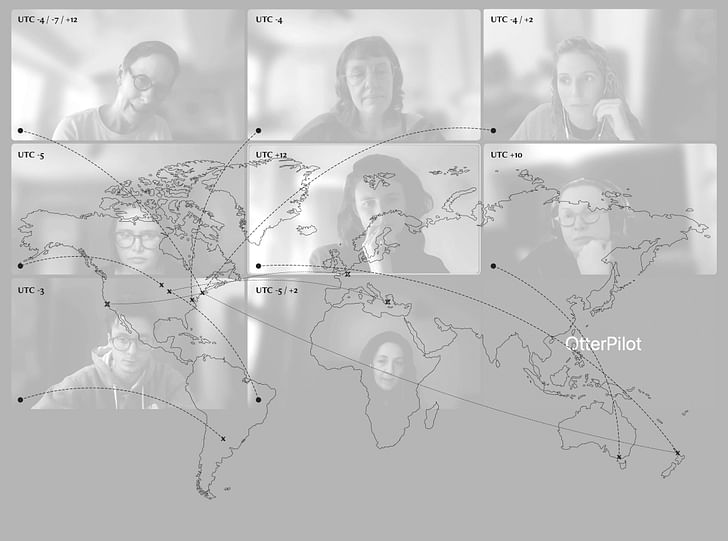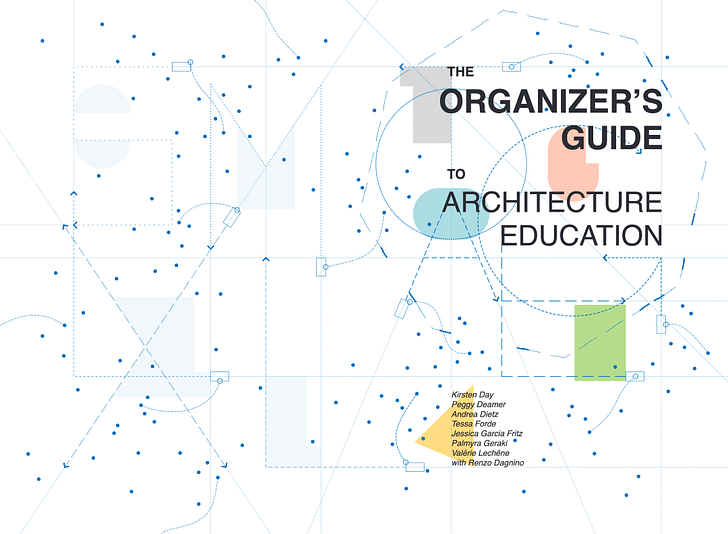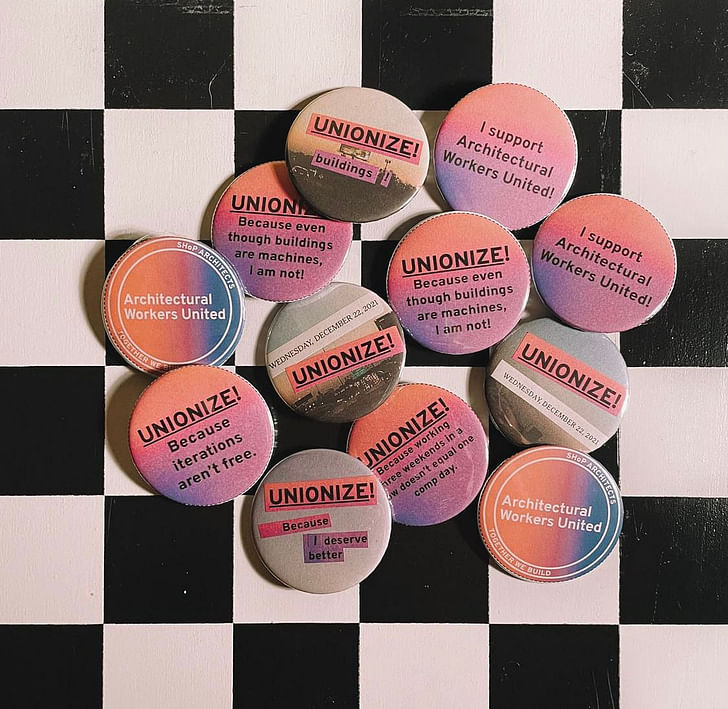

In recent years, the word 'organizing' has taken on a heightened power in architectural discourse, most notably through grassroots efforts by architectural workers across the United States to organize for better workplace conditions.
For Tessa Forde, organizing centers on a vast network of relationships that transcends different scales, disciplines, and actors across and beyond the architectural profession. In particular, Forde sees architectural education as an arena in which organizing holds great potential, with positive benefits for educators, students, the profession, the public, and the planet.
In that spirit, Forde is one of seven co-authors of the new book The Organizer's Guide to Architecture Education, alongside Kirsten Day, Peggy Deamer, Andrea Dietz, Jessica Garcia Fritz, Palmyra Geraki, and Valérie Lechêne. In October 2024, Archinect's Niall Patrick Walsh spoke with Forde about the book and its underlying message. The conversation, edited lightly for length and clarity, is published below.
Niall Patrick Walsh: One of the first things that struck me reading this book was how seven authors were able to speak with a collective voice. Could you give an insight into how so many points of view came together in a single publication?
Tessa Forde: The book itself was an exercise in organizing. We all knew each other before and had worked together online, particularly through our involvement in The Architecture Lobby. We had all joined the Lobby’s Academia Working Group and organized the Architecture Beyond Capitalism School during the pandemic.
One of our conclusions from that project was that organizing was an essential skill that needed to be introduced across architectural education. So, the seven of us spent about six months on a Zoom call every week simply talking about ideas. It was an enriching process. There was a lot of debate, and we didn’t agree on everything, but we could still come to a consensus.
From there, an outline eventually emerged, and we came up with a strategy for writing that was essentially a ‘round robin.’ We had all been reading and contributing to a shared bibliography, so we had a huge collection of literature that we all didn’t have to read but rather shared the load collectively. Each of us would have several weeks to write our chapter, and then we would rotate the chapters every week to a different author who would rewrite and edit. It was important for us to experiment with the strategy of organizing within the writing process, given the subject.
There are many complex interactions within the process that architects are already organizing, but this kind of ‘organizing skillset’ remains within practices and within the commercial context. — Tessa Forde
The book comes at a time when the term ‘organizing’ is becoming more prevalent in the architecture space. When we read this title, ‘The Organizer’s Guide to Architecture Education,’ what does ‘organizing mean in the context of the book?
Organizing is dependent on a vast network of relationships. You cannot just focus on the faculty because the faculty is part of a mesh of complex relationships, systems, flows of money, and the lived realities of students. Organizing is about power and discovering mechanisms and tools in order to understand power and power relationships. It is about empowering people to recognize their collective autonomy. I’m very interested in the ritual mechanisms that create and maintain those relationships.
Organizing is also about creating spaces that feel good, that make you want to be in them, where it is safe to be vulnerable. In this respect, designing the space of organizing is as important as the thing that you are organizing towards; that is what keeps the movement going.
Within architecture schools, architecture is already an ‘organizing’ discipline. It is the reorganization of materials and the organization of complex actors within that process. There are many complex interactions within the process that architects are already organizing, but this kind of ‘organizing skillset’ remains within practices and within the commercial context. So, organizing within architectural education is about asking how we start to organize the foundational ground underneath those disparate practices to leverage creative space for policy change and systemic change.

In the book, you break down the arenas for organizing into four scales: small, medium, large, and extra large. You begin with ‘small,’ which centers on the architecture school studio. What are the flaws within that scale that require organizing, and what are some approaches that can be taken?
If you imagine architectural education as a complex web, the studio is the foundational cornerstone. It is where students are taught the rules of the game of architecture and are socialized into the profession. The studio space hosts a hidden curriculum of social expectations, such as how you dress and behave as an architect. This is hugely influenced by the teacher, and there is a power dynamic between the students and teachers.
Even though the studio is a space free from constraints, it is strangely ubiquitous and similar across almost all architecture schools in the world. It is a space of creative imagination but is also a reflection of industry standards and of the necessity through accreditation to deliver a particular set of outcomes.
The studio occupies a huge space within the curriculum. It does develop critical thinking skills, but it can also become a distraction from other topics. My experience at architecture school was that studio was number one, and thinking about my tech paper was number ten on the list of priorities; likewise, with history, theory, and other important subjects that are very compartmentalized.
This complex balance between professionalism and creativity, or between rationality and passion, defines architectural education. Therefore, there is an opportunity to start with the studio and create a space that can support organizational thinking and a redefinition of architectural skills; one that is a more adaptive approach to practice. The studio presents a real place for fleshing out those ideas because it is already intimate, it is already smaller groups of people that have to organize themselves against some kind of project.
If you want to design a chair, you need to organize the process and think about how you are going to relate to other people, how you are going to relate to the materials that you are using, where those materials come from, etc. Learning about power dynamics within a material process, within a relational process, can apply to problems at all scales. This opens up the studio spaces as a really effective place to apply the skills of organizing, and to develop them. The studio can become a lot more collaborative, and more integrated into real problems, but still remains this kind of virtual reality space for practicing in the real world and understanding the world in different ways.
What do we bring to the city? How do we teach that? What is missing from our skillset? These are the kinds of questions that organizing can encourage. — Tessa Forde
Reading the book, it dawned on me how ‘object-focused’ the studio can be. Briefs are about the building, the site, and the non-human; we are focused too much on crafting an object. You talk in the book about re-centering that focus on ‘people’ not only through briefs that focus more on users and communities but through building design teams in schools that take in other disciplines beyond architecture. It circles back to what you mentioned earlier: Organizing is about people.
I feel that there are practices out there in schools that imagine other ways, but they are not ubiquitous; they are the exception to the rule. Within my own education, I had studios that differed from the norm, but it was considered radical to take that class that seemed to imagine another way of interacting with the city or place. Hopefully, there is a series of case studies within this book that capture some of these moments. Part of the organizing process is about finding the people who are imagining these other ways and connecting them. It is important to focus on the hyperlocal but also to imagine how those hyperlocal practices can start to be connected.
As you say, there is often a focus on ‘architecture’ rather than the ‘architect.’ I’m not talking about reinforcing a ‘starchitect’ type of individual, or the idea of individual exceptionalism, which is still prolific within architecture. Instead, it is about asking: What are the skills that architects have? What perspectives can we bring? Architecture was professionalized on technical skill sets, which are very difficult to protect. Most architectural licensure is just titular in nature, and in Aotearoa New Zealand there are other modes of designing buildings that do not require architects at all. We need to ask: What do we bring to the city? How do we teach that? What is missing from our skill set? These are the kinds of questions that organizing can encourage.
This leads nicely to talking about the next scale: medium. The studio is only one module, and we make the argument that this needs to be scaled up in context. In some ways, that is what organizing is. You identify a problem, and you can infinity-scale it to understand it in context.
So, we go from small to medium, which is the curriculum. In many architecture schools, you have a curriculum of studio, representation, construction technology, history and theory, and professional practice. These silos really limit interdisciplinary integration and imply that they are also siloed in the real world.
The studio might be a good place to start organizing, given that educators have some autonomy at that scale, but organizing needs to take place within the faculty or within the teaching staff to organize across the curriculum. Then we can create a curriculum that becomes more integrated and more responsive to local contexts and the particular programs of a place. When you start to address problems locally, you can then start to think about them at a global scale through the organizing lens. The curriculum can become a laboratory for practice, a space to experiment with what architectural practice is and how it can be organized differently, particularly in response to local and then global needs.

Then, we have the ‘large’ arena, in which you talk about the university and its relationship with towns, cities, and communities around them, or lack thereof. How does organizing manifest on that scale?
It’s important to say that none of this is easy, and there are so many academics working hard to try and change things who are coming up against roadblocks at every turn. The whole system is antithetical to this kind of thinking. Part of the reason that we have case studies in the book is to say that this is happening and people are trying. We need to learn from each other and create better spaces together.
This kind of faculty organizing at the curriculum level is also an opportunity for the faculty to come together to practice organizing, and design how they want to organize. Hopefully, we can then extend this upwards, because you cannot reorganize the curriculum without support from higher powers within the university.
Part of that is understanding the complex system of how money flows through universities. The history of universities is fraught and often contains land grabs, particularly in the wealthiest U.S. universities. Wealth was built off stolen land, slavery, and other terrible practices. They are maintained through the capitalist system, so there has to be a way of understanding those power dynamics and organize to both understand them, leverage them, and change them.
Again, this is all very difficult. There are many steps that have to happen before this. The gradual changes that need to happen are dependent on this capacity to really understand the neoliberal university; a university that is very bureaucratic and motivated by cost-saving and by profit motivations even within public universities. Trying to call out labor practices for teachers, but also advocate for students, can create spaces for students to advocate for themselves, create inclusive governments, and expand beyond the boundaries of the universities.
Universities, particularly wealthy universities, have so many resources. Those resources should be accessible to everybody, particularly in the places where those universities are housed. There needs to be a way of leveraging those resources to create community impact.
Trying to call out labor practices for teachers, but also advocate for students, can create spaces for students to advocate for themselves, create inclusive governments, and expand beyond the boundaries of the universities. — Tessa Forde
The final scale is extra large, where you address the nation-state. You address governments, international connections, and the future of the profession, whether that be through deprofessionalization, reprofessionalization, or other approaches. What does organizing look like on that scale?
This chapter is about examining the relationship between the architectural academy and nation-state ideologies, which have a huge influence on the profession. The nation-state controls architecture through licensure and then promotes specific ideologies through that which shape architecture and our cities. These regulations of course extend beyond licensure as well because there is particular legislation that encourages certain types of building.
The nation-state creates these artificial divisions that impact cultural affinities and uphold capitalist policy. This hinders architects from addressing global issues. It is difficult to negotiate across borders and complex frontiers, so it is difficult to take a position on what the solution is. But we can start with the small and scale from there while recognizing that the definition of architecture is shaped by state licensure and that is the place within which we have some power or knowledge to change.
Interestingly, Australia and Aotearoa New Zealand have recently overhauled their accreditation to an ambitious and aspirational set of requirements. There are more clauses about environmental regeneration and sustainability, as well as working meaningfully with Indigenous communities. However, the difficulty is that the instrumentation through which to achieve those changes is not conducive to tackling those kinds of problems. A lot of universities are finding it difficult to maintain their accreditation because they are not provided the tools, or it is difficult to develop the tools in a short space of time, to create connections with Indigenous communities that are not exploitative or that are not just for the sake of accreditation.
These relationships require deep care, time, and skill sets that many people do not have. This is what organizing is about. It is about saying, “Okay, let’s take this time to talk to each other and have these conversations.”

To summarize, then, who should read this book?
It definitely starts with educators and students. But we also have a hidden fifth scale, which is the planetary scale. There is a problem in how we perceive education, where it stops at the master's degree. But we cannot just educate future generations and put that much pressure on them to solve the problems of society. It’s not fair. We have to organize across practices and offices that are already doing this work or trying to find ways of doing it but do not know how.
We need a space for experimenting together and developing organizational practices outside of academia. These are spaces that can still retain the spirit of speculative imagining but can deal with real-life problems and connect to offices across knowledge and disciplines. In some ways, this is antithetical to the professionalized model that compartmentalizes disciplines.
This book is, therefore, for architects too. We have to create spaces together to organize, to talk about approaches that engage in a particular way, work well, and could be applied more broadly. How do we advocate for that in a collective way and not as just one or three people in a small practice working hard on one problem? We need to create a mesh of interactions.
We need a space for experimenting together and developing organizational practices outside of academia. — Tessa Forde
Finally, when someone finishes this book, what should they read next?
My favorite book that I read through my research was Research is Ceremony: Indigenous Research Methods by Shawn Wilson. In the book, Wilson is writing to his seven-year-old son, so he completely demystifies the language of academic research. A second book I recommend is Ideas to Postpone the End of the World by Aílton Krenak. It offers a great inroad into the kind of pluralistic thinking that we need to encourage. The last book is Virtue Hoarders: The Case Against the Professional Managerial Class by Catherine Liu, which is a useful framework for understanding the bureaucratic system of institutions and the intersections of class.
Niall Patrick Walsh is an architect and journalist, living in Belfast, Ireland. He writes feature articles for Archinect and leads the Archinect In-Depth series. He is also a licensed architect in the UK and Ireland, having previously worked at BDP, one of the largest design + ...
No Comments
Block this user
Are you sure you want to block this user and hide all related comments throughout the site?
Archinect
This is your first comment on Archinect. Your comment will be visible once approved.